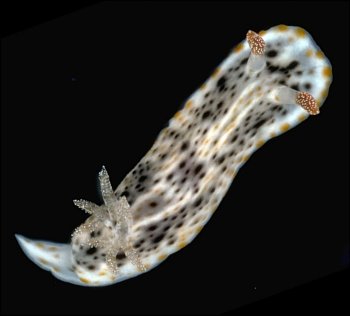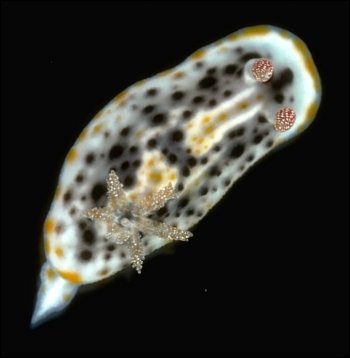

Chromodoris striatella
- spotted form
Order: NUDIBRANCHIA
Suborder: DORIDINA
Superfamily: EUDORIDOIDEA
Family: Chromodorididae
DISTRIBUTION
Indo-West Pacific
PHOTO
UPPER: Lagoon between mainland and Récif de l'Infernet, off Koumac, New Caledonia, 20°34.4'S, 164°13'E, 12m, Silty bottom with dense gorgonian beds 18 October 1993, 2 specimens (13, 16mm long alive), AM C200521.
LOWER: Koumac Beach (=Baie de Ouanap), near Koumac, New Caledonia, 20°34'S, 164°16'E, Mixed soft and hard substrate, grassbeds, algae, 27 October 1993, 19mm long alive, AM C200662.
PHOTOS: Bill Rudman.
Although seemingly quite different from Chromodoris striatella I have seen animals in New Caledonia, both lined and spotted living together, and occasionally with an intermediate pattern in which some of the rows of spots are joined to form partial black and orange lines. If you look at the photo of an almost 'unlined' colour form, the same two pale patches, one in front of the gills, the other behind the rhinophores, can be seen. No major anatomical differences have been found.
It is probable that the recently described Chromodoris mandapamensis is a dark example of this same colour form. See also a photo of an intermediate with lines and spots.
Authorship detailsRudman, W.B., 2000 (August 13) Chromodoris striatella - spotted form. [In] Sea Slug Forum. Australian Museum, Sydney. Available from http://www.seaslugforum.net/find/chrstriavar
Related messages
Chromodoris mandapamensis? from Thailand
September 20, 2001
From: Narongpon Sittitaweepat

Dear Bill
I can't identify this nudibranch. Songpol Amnartsingh found it at Ko Sak Pattaya, Thailand. He didn't record date and depth.
Thank you
Narongpon Sittithaweepat
ning@talaythai.com
Sittitaweepat, N., 2001 (Sep 20) Chromodoris mandapamensis? from Thailand. [Message in] Sea Slug Forum. Australian Museum, Sydney. Available from http://www.seaslugforum.net/find/5272Dear Narongpon,
I have suggested in earlier messages that this is a spotted form of Chromodoris striatella. I think it is also what has been described as a separate species, Chromodoris mandapamensis, from India. Until we have some more information on these animals - what do they eat? what do their egg masses look like etc I can't really say whether you should call it C. striatella or C. mandapamensis.
Best wishes,
Bill Rudman
Re: Spotted Chromodoris striatella
September 2, 2000
From: Bruce Potter
Dear Bill,
Regarding the possible Chromodoris striatella, I found three of them. One was very small, and obviously juvenile, the other two were together, one slightly larger than the other. All were marked identically.
Bruce
bruce.potter@adventist.org.sb
Potter, B., 2000 (Sep 2) Re: Spotted Chromodoris striatella. [Message in] Sea Slug Forum. Australian Museum, Sydney. Available from http://www.seaslugforum.net/find/2947Thanks Bruce,
Bill Rudman.
Spotted Chromodoris striatella
August 24, 2000
From: Bruce Potter

Dear Bill,
I have been given your address as a nudibranch expert who may be able to help me identify the enclosed beast.
I live in Honiara, Solomon Islands and have been diving here for 11 years. Nudibranchs are one of my chief interests. Since the unrest here during the past couple of years, we have been confined largely to just one small site. It is a rubbly area with sea grasses. Over the past year I have filmed more than 50 different nudibranchs on this one site.
I can usually identify them from my books, but this one has me stumped.
Are you able to cast any light on it?
Regards
Bruce Potter.
bruce.potter@adventist.org.sb
Potter, B., 2000 (Aug 24) Spotted Chromodoris striatella. [Message in] Sea Slug Forum. Australian Museum, Sydney. Available from http://www.seaslugforum.net/find/2918Dear Bruce,
This is quite an interesting find and has arrived at a fortuitous time. Valda Fraser has recently sent a photo of a similar animal from South Africa and Angel Valdes has also sent a photo of Chromodoris mandapamensis from India which maybe the same thing.
I have suggested that it is a spotted form of Chromodoris striatella. In your specimen you can definitely see traces of the white longitudinal lines. Any more photos of intermediates between the spotted and lined forms would be very welcome.
Best wishes,
Bill Rudman.
Spotted from of Chromodoris striatella
August 15, 2000
From: Valda Fraser

Dear Bill
A new find for me! I hope you know its name.
Locality: Aliwal Shoal, Umkomaas, KwaZulu-Natal, SOUTH AFRICA - 15m
Date: July 2000
Size: 20mm
Thanks.
Valda Fraser
iti04937@mweb.co.za
Fraser, V., 2000 (Aug 15) Spotted from of Chromodoris striatella. [Message in] Sea Slug Forum. Australian Museum, Sydney. Available from http://www.seaslugforum.net/find/2841Dear Valda,
This is an interesting find. I have an answer to its identity, which I was going to keep 'unpublished' until I had some irrefutable photos to show an intermediate stage between this colour form and Chromodoris striatella. I did in fact find some juveniles in Koumac, New Caledonia, in 1993, but of the 40 rolls of film I exposed there, the only photos I had were on 3 rolls which were ruined by some disaster with the flash. I have posted some photos of the spotted form from New Caledonia, above.
However with your photo, and Angel Valdes' posting on Chromodoris mandapamensis, it seems a bit silly not to draw everyone's attention to the real possibility that C. striatella has a spotted colour form. Valdes, Mollo & Ortea (1999) mention the similarity in colour pattern between C. striatella and C. mandapamensis but say the latter is clearly distinguished by the spots. From my observations I don't think the spots are a clear distinction at all.
It would be nice to discover what sort of egg ribbon the spotted form produces. C. striatella is one of the few chromodorids in which the egg ribbon is layed flat on the substrate, like a sacoglossan, rather than attached along the edge of the ribbon. Other points of interest would be to see what sponge it feeds on, whether it associates with lined C. striatella, and best of all whether it mates with lined C. striatella - Just a few little things to look out for on your next dive.
Best wishes,
Bill Rudman.
